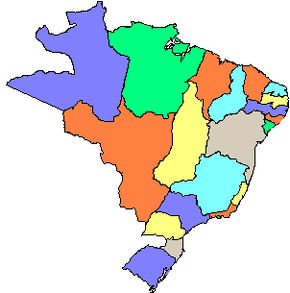
Map of Brazil, 1910.
The Empire of Brazil remained the only monarchical nation in South America in the 20th century, after a military coup failed to ensure a republic in November 15, 1889. The leaders of the coup, chiefly Benjamin Constant and Lopes Trovão, were arrested and sentenced to life prison. The commander of the Army, Marshal Deodoro da Fonseca (a staunch monarchist), instead of proclaiming the Republic was convinced to take the post of Chairman of Council of Ministers (head of Government, prime minister). He would resign the following year and was replaced by Rui Barbosa, a brilliant orator and diplomat, and a moderate republican turned loyalist.
After the natural death of Emperor Pedro II in 1898, his heiress Isabel I takes the crown as Empress. Her French husband Gaston, Count of Eu, is unpopular and threatened by radical activists, especially anarchists. A few extreme republicans, called "jacobinos", still remain, planning to overthrow Empress Isabel at any time. But their lack of support in society and among the Navy has drastically reduced their power since then.
Taking the 1889 coup as point of divergence, the following text and data apply to alternative timeline as of 1910.
Government[]
Brazil is a constitutional monarchy since 1824, in which the Empress retains the Moderate Power and appoints the cabinet members according to their caucus in the Parliament. The chairman of the cabinet is the head of government, like a prime minister (but called Presidente do Conselho).
Broad electoral reforms in 1885 (OTL) and 1890 (ATL) have democratized suffrage and the political system. Presidents of Provinces (Governors) are now elected by the provincial assemblies and Senators are no longer for life, but limited to a ten-year term. Municipal Intendentes (Mayors) are still appointed by the governors.
Prime Ministers 1889-1910[]
- 1889-1889 - Visconde de Ouro Preto (Liberal)
- 1889-1890 - Deodoro da Fonseca (coalition)
- 1890-1892 - Rui Barbosa (Liberal)
- 1892-1897 - Joaquim Nabuco (Liberal)
- 1897-1902 - Prudente de Morais (Conservative)
- 1902-1906 - Rui Barbosa (Liberal)
- 1906-1907 - Quintino Bocaiúva (Liberal)
- 1907-1911 - Barão do Rio Branco (coalition)
Emperors[]
Politics[]
After 1889, the political parties in Brazil split between Loyalist Liberals, Republican Liberals, and Jacobinos (radical republicans), besides outlawed groups such as the anarchists and socialists. The Conservatives were kept as such, but had internal wings between industrialists and ruralists.
The Sertão (hinterland) was mainly pacified. Without the republic, there were no such conflicts as Canudos and Contestado, but local religious and political leaders retained strong rule in their communities. The power of coronéis (oligarchic landowners) was reinforced by the Imperial Government as a mean to prevent republican attempts in the provinces. They built private armies and police forces known as jagunços, to fight the cangaceiros (bandits), with support by the Empire, who feared strengthening the Army to avoid republicanism. Messianic leaders such as Antônio Conselheiro arose and were fought by these landowners as religious freaks.
Administrative division[]
The 20 provinces of Brazil are the same as in 1889, and were kept unchanged since then. The Município Neutro (also called Corte Imperial, Imperial Court) holds the capital city of the Empire, Rio de Janeiro.
- Alagoas - capital: Alagoas
- Amazonas - capital: Manáos
- Bahia - capital: Salvador
- Ceará - capital: Fortaleza
- Espírito Santo - capital: Victoria
- Goyaz - capital: Goyaz
- Mato Grosso - capital: Cuyabá
- Maranhão - capital: São Luiz
- Minas Geraes - capital: Ouro Preto
- Pará - capital: Bellém
- Paraná - capital: Curityba
- Pernambuco - capital: Recife
- Piauhy - capital: Terezina
- Rio de Janeiro - capital: Petrópolis
- Rio Grande do Sul - capital: Porto Alegre
- Rio Grande do Norte - capital: Natal
- Parahyba - capital: Cidade da Parahyba
- Santa Catarina - capital: Desterro
- São Paulo - capital: São Paulo
- Sergipe - capital: Aracaju
Economy[]
Brazil is still heavily dependent on coffee planting and exports, but the abrupt end of slavery in 1888 brought a serious problem about workforce. Some European impoverished workers (mainly Italians) were attracted as immigrants, but with little support from the Government, they shortly felt deceived and moved to neighbouring countries such as Argentina and Uruguay, or back to their homelands.
Manufacturing is still very poor and concentrated around São Paulo and Rio de Janeiro. The government is building a new major port in the South, around a town called Paranaguá, in the Paraná province.
Foreign relations[]
The borders of the Brazilian Empire in 1910 were almost the same, yet slightly smaller, than those of Brazil in 1889 OTL. This is because the Imperial government did not favour Barão do Rio Branco (who was chief diplomat and Foreign Minister in OTL), so the country lost all territorial disputes with neighbors, such as Argentina (Palmas), Venezuela, Britain, and France (Cunani). The loss of Acre to Bolivia and Peru in 1900-1903 after a brief war sponsored by an American syndicate, was also heavily faced and cost less tons of rubber per year to the Empire. Brazil also had a mediocre part in the Hague Conference of 1908, when Rui Barbosa was away from official diplomacy and could not be sent as the national delegate. The country also had troubles after supporting Spain in the Hispano-American War of 1899 and suffered sanctions from the United States.


